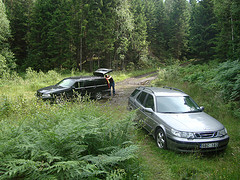Don’t look now but some people who are buying off-road-capable vehicles like SUVs are actually taking them off-road. In fact, the trend has become so significant that the U.S. Forest Service just created a new regulation to standardize the way off-highway routes are designated in the lands it administers. The goal is to change the haphazard way trails and the vehicles that can use them are authorized to protect the forests while still allowing use by a large number of Americans. Predictably, the new rule is drawing fire from both environmentalists and gung-ho off-road vehicle fans.

flic.kr/p/cthU5b
First, it should be noted that something had to be done. Virtually all Americans are doing it outdoors (97.5 percent of the population, according to a 2000 survey), and, more to the point, from 1946 to 2000 the number of National Forest visitors grew 18 times. In 2002, 214.1 million Americans made National Forest visits, which resulted in 256.2 million National Forest site visits overall.
While the picture you might have in your head is of a solitary hiker with a backpack on his or her back striding confidently thorough the forest, the fact is that many wilderness treks are taking place in motorized vehicles. Nationwide, there has been a sevenfold increase the in number of off-road-vehicle owners and users in the last 30 years. The number jumped from five million off-highway vehicles (OHVs) in 1972, to 19.4 million in 1983, to 27.9 million in 1995, to almost 36 million in 2000. And in the five years since these figures were gathered the number has grown even higher. Estimates indicate that of all National Forest visits more than 11 million involve off-road vehicle use in off-road situations.
Risks and damage increase
What does this mean? In addition to indicating that millions of Americans are enjoying the outdoors in their National Forests, it also means each year hundreds of miles of new, unplanned roads and trails are created. Erosion, recreation use conflicts, spread of invasive species, damage to cultural resource and historical sites, disturbance to wildlife, destruction of wildlife habitat, and even risks to public safety are potential results along with untold learning experiences and uncalculated amounts of pure fun.
On July 15, 2004, the Forest Service published proposed travel management regulations in the Federal Register. Then, less than two weeks ago, after extensive public comment, Forest Service chief Dale Bosworth announced the new plan, which looks to standardize what are now haphazard procedures in designating off-road-vehicle trails and approving appropriate vehicles.
The rule requires each national forest or ranger district to designate individual roads, trails and general areas open to motor vehicles. Designation will include the class of vehicle that can use each trail or area and, if appropriate, the time of year for motor vehicle use. A given route, for example, could be designated for use by motorcycles, ATVs or street-legal vehicles or any combination.
New rules may help
In an attempt to put an end to the blazing of new trails, a practice that is rampant within some National Forests today, once the designations are put in place, those will be the only trails and areas open to motor vehicle use. The rule will prohibit motor vehicles off the designated system or inconsistent with the designations.
While this is certain to rile dedicated off-roaders who would like wider access to unspoiled areas, the good news is that decisions will be made locally, with public input and in coordination with state, local and tribal governments. Meanwhile, environmentalists, some of whom would like to severely limit motor vehicle access to National Forest lands, will be lobbying to take as many trails and other areas off the designated list as possible.
—Cleveland-based writer Luigi Fraschini, a Driving Today contributing editor, is a staunch believer in conservation and the limited use of motor vehicles in wilderness areas. © Studio One Networks.
Filed under: Save Gas & Earth